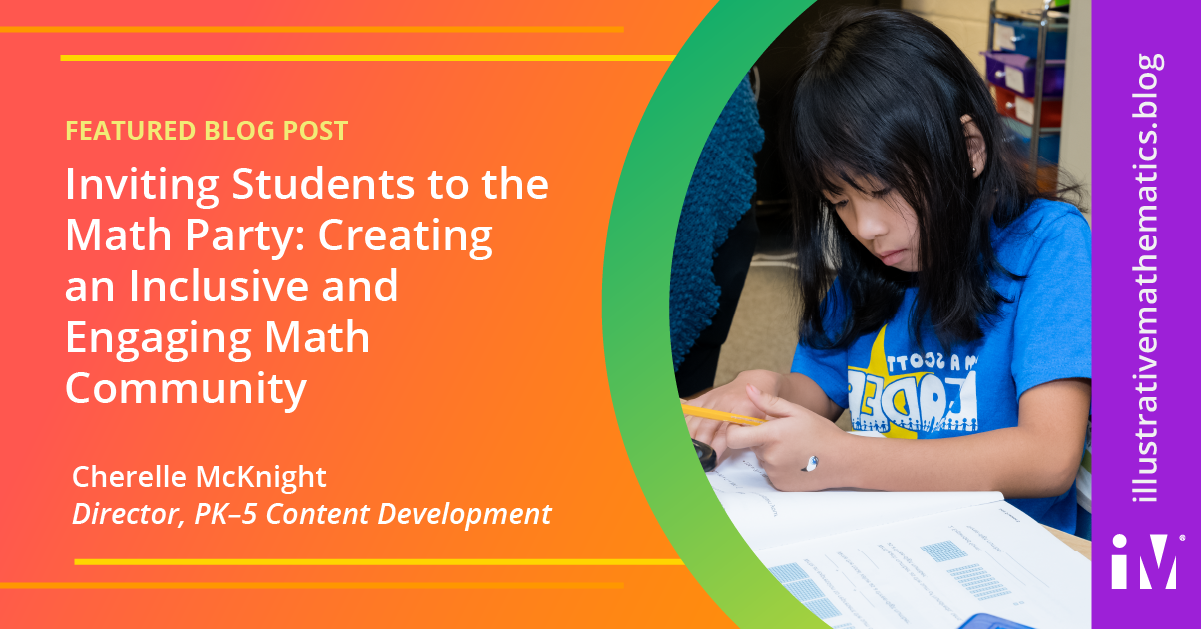By Cherelle McKnight, Director, PK-5 Content Development
At one of my former schools, students who passed out birthday party invitations had to invite their entire class. While I disagreed with how the policy was implemented, I understood the spirit behind it. It’s a terrible feeling to realize everyone, except you, has been invited to “THE Party.” Unfortunately, some students have this feeling in math class.
Every day presents a fresh opportunity to invite your students to a math party. A math party should give every student the opportunity to authentically engage and participate in math class and to experience math joy. It should be a chance to help students develop and continuously build a positive mathematical identity. By using the invitations built into the Illustrative Mathematics K–5 curriculum, you can create an inclusive and engaging math community, where students feel socially and intellectually safe. You can be the host who welcomes all your students to the math party.
The IM K–5 curriculum offers many opportunities to invite students to the mathematics. For example, every lesson begins with a warm-up. The warm-up invites students to bring their personal experiences as well as their mathematical knowledge to problems and discussions. As teachers facilitate the warm-up, they should listen not only for content-related sharing, but also for personal sharing. This listening is crucial because when students share their personal experiences, they are extending an invitation to us. They’re inviting us to get to know them better. They’re inviting us into their world and, possibly, into their culture.
In Zaretta Hammond’s 2014 book, Culturally Responsive Teaching and The Brain: Promoting Authentic Engagement and Rigor Among Culturally and Linguistically Diverse Students, she explains, “Culture, it turns out, is the way every brain makes sense of the world. That is why everyone, regardless of race or ethnicity, has a culture. Think of culture as software for the brain’s hardware. The brain uses cultural information to turn everyday happenings into meaningful events. If we want to help dependent learners do higher-order thinking and problem solving, then we have to access their brain’s cognitive structures to deliver culturally responsive instruction.“ (p. 22)
When students share their personal experiences during the “everyday happening” of an IM warm-up, they are attempting to make the event meaningful. At the same time, they’re trying to reconcile what they know to be true in their world with the new information presented to them. By encouraging such personal responses, IM’s invitational warm-ups help students access their higher-order thinking and problem-solving abilities. (Keep in mind that a typical warm-up is slated for 10 minutes. So, it may be necessary to make note of some personal experiences that students share and revisit them later to further build connection and community.)
Another component of the IM K–5 curriculum that invites students to the math party is the launch. Each activity, including warm-ups, starts with a launch that gives all students access to the upcoming task. Through purposeful grouping and thinking time, the launch creates an environment where all students can be involved.
Let’s look at a warm-up from IM Grade 5:
Grade 5, Unit 3, Lesson 1, Warm-up

Consider how the open-ended nature of the warm-up fosters inclusivity by inviting students to actively participate in the discussion. It encourages them to share their personal experiences related to the context, such as their preference for macaroni and cheese or their adventures in cooking. These anecdotes allow for a deeper engagement with the topic at hand.
Additionally, the warm-up provides an opportunity for students to apply their mathematical knowledge. For instance, they may notice that the pan resembles a rectangle and wonder about its size. Alternatively, they might notice that the pan is not completely filled and wonder about the quantity of food consumed.
Importantly, there are no right or wrong answers in this warm-up. The objective is to create a welcoming environment for everyone to contribute to the math party.
Here is the launch for this warm-up:

Notice that the launch starts by grouping students. To encourage participation, nearly every warm-up involves students working in groups. No one sits alone at this math party.
As teachers plan the grouping, they should ask themselves, “Am I considering how this experience may or may not feel invitational to my students? Am I inviting them in a way they may like or need to be invited?”
Here are only a few possibilities a teacher might consider:
- Group a student who is willing to share their social capital with a student who needs someone to “pass them the mic” so they can be heard.
- Group multilingual learners who share a native language so they can make sense of the context or math in that language.
- Group students who had similar responses to the previous day’s cool-down so they can continue their thinking together.
The considerations for grouping may change based on the activity, but it is important for us to have considerations. We must be intentional if we intend to be invitational.
Here are the activity instructions for this warm-up:

As teachers facilitate the warm-up, they should consider how to use these moments to learn more about their students’ culture and content knowledge. For example, a group may be comfortable speaking to each other, but they’re not yet ready to speak out in class. Teachers could check in with that group near the end of the warm-up to hear their thoughts or to revoice their earlier discussion. Doing so may invite those students to share on their own the next time—or the time after that. Another group may have made a similar connection on the cool-down from the previous day. As a result, those students might better receive today’s invitation to the mathematics because the excitement from the previous day continues. Or they might have a chance to work toward joy now because the uneasiness from the previous day has been addressed.
These are only a few examples. IM warm-ups offer multiple opportunities to collect information about students that will help you craft more intentional invitations in the future.
It may be a cliché, but it’s still true: People don’t care how much you know, until they know how much you care. We can show our students that we care by extending genuine, intentional invitations. We can make sure that when we invite them to the math party, we play some of their favorite songs and provide some of their favorite snacks. We can make sure to pay attention to the personal experiences they share, so in the future, we can make connections to the content and their culture. In doing so, we reassure students that we are intentional about inviting them to the math party and we’re glad they came.
As you plan for an upcoming lesson/math party, consider:
- the intentional decisions you will make to extend an invitation to all students
- the adjustments you will make to the invitation if it is ignored
- the lengths you will go to in order to make sure every student feels invited and included in your math community
 Cherelle McKnight
Cherelle McKnight
Director, PK-5 Content Development
Cherelle McKnight (she/her/hers) received a BA in audio production and a minor in human development from Howard University. Cherelle went on to complete her MA, specializing in PK–5, at Mercer University.
Cherelle has served as a mathematics teacher, coach, curriculum and instruction specialist, and consultant. She is passionate about supporting students and teachers and helping them develop positive mathematical identities. Cherelle is currently the director of PK-5 content development. Beyond her professional pursuits, Cherelle enjoys playing Mario Kart. She and her wife are the proud pawrents of a Frenchie.
